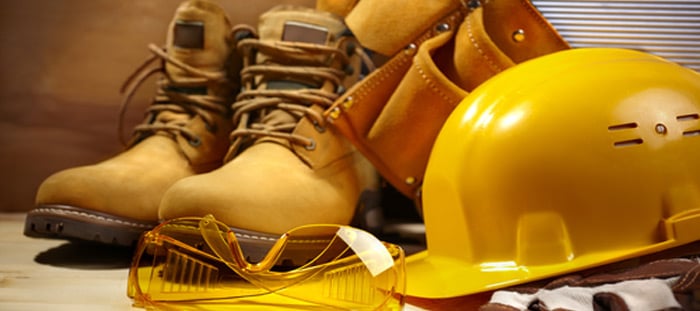In the construction industry, personal protective equipment (PPE) is considered the last line of defense when it comes to protecting workers from injuries on the jobsite. Employers are required to implement engineering controls and other safety measures to guard against accidents and prevent injuries. In the event those measures fail or can’t be feasibly implemented, PPE is there to prevent an injury when hazards arise.
Employers are required to pay for and provide workers with all PPE and are responsible for requiring their use when appropriate. All PPE should meet the American National Standards Institute (ANSI) specifications.
Employers can allow workers to use their own PPE. If employee-owned equipment is permitted, employers are responsible that the PPE is in good working condition, but are not required to reimburse workers for PPE they provide themselves.
In order to best provide protection to your workers, here are some tips for ensuring proper use of PPE:
Develop a Personal Protective Equipment (PPE) Program
Your PPE program should outline hazards present and the proper PPE that is to be worn. The program should explain how to select and ensure the proper fit for PPE. The PPE program needs to cover proper inspection and maintenance of all PPE.
Training workers on the proper use and safety benefits of PPE should be covered in your program. Make sure to post signage alerting workers to the PPE they should be wearing in different areas of the jobsite.
Head Protection
Hard hats protect workers from falling and flying objects to prevent striking head injuries. They also insulate from electric shock. Because conditions on construction sites are constantly changing, a good rule of thumb is to require everyone on the jobsite to wear a hard hat at all times.
Be sure to follow the manufacturer’s directions for adjusting the suspension in the hard hat to ensure a comfortable and secure fit. Don’t stuff anything in the hard hat while wearing it, as it could compromise the gap between the shell and the suspension.
Refer to the manufacturer’s recommendations if you are considering painting or affixing stickers to hard hats. Most manufacturers don’t recommend painting the hard hat as the paint can damage the shell, but are usually okay with affixing stickers to the hard hat.
Some hard hats can be worn backward as long as the suspension can be reversed. Ball caps should not be worn under the hard hat. Winter liners and cooling headwear are typically fine to use with hard hats as long as they can be worn seated down on the head and don’t interfere with the suspension bands.
Hard hats should be inspected for damage such as cracks and dents before each use. Damaged hard hats should be discarded and replaced.
Hearing Protection
Hearing protection must be provided and used when noise levels or duration cannot be reduced to those specified in Table D-2 - Permissible Noise Exposures of OSHA standard number 1926.52.
Acceptable hearing protection included earmuffs and earplugs which are to be fitted into the ear. Earplugs must be individually fitted by a competent person. Plain cotton is not an acceptable protective device according to OSHA.
Eyes & Face Protection
Eye and face protection is needed when workers are exposed to hazards from flying particles, molten metal, liquid chemicals, acids, caustic liquids, chemical gases, vapors, and light radiation.
For workers who wear corrective lenses, prescriptions should be incorporated into the design of the eye protection or the eye protection should be designed to be worn over the prescription lenses.
Face masks, safety goggles, and safety glasses should be selected based on the hazard they were designed to protect workers from. It should fit snugly and comfortably and not interfere with a worker’s movement. Protective eyewear should be durable, cleanable, and capable of being disinfected.
When workers are performing welding operations, make sure they are provided with the proper filter lens shade number based on the type of welding they will be performing. When working with lasers, safety goggles with the appropriate optical density based on the wavelength of the laser should be used.
Hand Protection
Select the right glove for the job. The hand is the most commonly injured body part at the jobsite. Gloves should fit snugly and comfortably while still allowing for full dexterity of the fingers. You don’t want workers removing gloves because they don’t fit properly or because they can’t feel what they are doing when working with tools or equipment.
There are gloves designed to protect against a number of hazards on the jobsite: gloves to protect against cuts and lacerations, welding gloves, heavy-duty rubber gloves for working with concrete, chemical-resistant gloves to protect against burns, and insulated gloves when performing electrical work.
Foot Protection
When most people think of foot protection on the construction site, they think of steel or composite-toed boots. These protect workers from tools, materials, or equipment falling or dropping on the foot.
Composite-toed and steel-toed footwear both offer a high level of protection with steel-toed boots getting the slight edge. Composite-toed boots are lighter and don’t conduct heat which makes them preferable if you are working outside in extreme heat or cold temperatures. They also don’t conduct electricity which is good if you are doing electrical work or work around live wires.
When selecting foot protection, you also want to choose footwear that is slip-resistant, to protect against slips and falls, and with puncture-resistant soles, to protect against sharp objects like misplaced nails.
Provide Training
Workers need to be trained on the proper selection and use of PPE and which PPE is needed for various jobsite conditions and tasks. Workers who are assigned to wear PPE should know how to put it on and take it off as well as how to adjust it to ensure a proper fit. Make workers aware of the capabilities and limitations of the PPE they are required to wear.
Workers should be able to properly inspect PPE before each use to determine if it is damaged and needs to be replaced or repaired. They should also be taught the proper way to maintain and care for the equipment.
Conclusion
PPE is an important aspect of keeping workers safe on the construction site. When engineering and administrative controls fail or aren’t feasible to implement, PPE is vital in protecting workers from injuries when accidents occur.
PPE should be comfortable and fit properly so it doesn’t interfere with a worker’s ability to safely perform their job duties. Safety managers and supervisors should routinely inspect the jobsite to make sure workers are wearing the assigned PPE and make determinations if additional equipment is needed.
Looking for more project leads? ConstructConnect finds you the best construction projects to bid on and win more work.
About Kendall Jones
Kendall Jones is the Editor in Chief at ConstructConnect. He has been writing about the construction industry for years, covering a wide range of topics from safety and technology to industry news and operating insights.


 Sign In
Sign In



